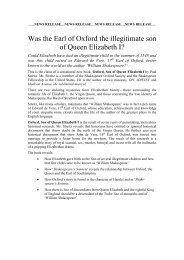Oxford and the King James Bible - Shakespeare Identified, Edward ...
Oxford and the King James Bible - Shakespeare Identified, Edward ...
Oxford and the King James Bible - Shakespeare Identified, Edward ...
You also want an ePaper? Increase the reach of your titles
YUMPU automatically turns print PDFs into web optimized ePapers that Google loves.
Stratford, <strong>the</strong> account of <strong>the</strong> work of <strong>the</strong> committee assigned to <strong>the</strong> KJV is quite mysterious. There are no<br />
records of meeting, correspondence between <strong>the</strong> various members. There are no records or notes of <strong>the</strong> work<br />
<strong>the</strong>y did in altering <strong>the</strong> KJV. Fur<strong>the</strong>r, <strong>the</strong> KJV is written in one steady, very artistic h<strong>and</strong>. If <strong>the</strong> work were <strong>the</strong><br />
collaboration, <strong>the</strong>n one would expect to find differences in style between <strong>the</strong> parts assigned to various groups,<br />
but no such variations exist.<br />
This has led to <strong>the</strong> <strong>the</strong>ory of <strong>the</strong> “hidden genius” to account for <strong>the</strong> stylistic unity of <strong>the</strong> KJV, but<br />
unfortunately no member of <strong>the</strong> group assigned to <strong>the</strong> task had any literary talent whatsoever. So, <strong>the</strong> hidden<br />
genius <strong>the</strong>ory founders on <strong>the</strong> lack of any suitable or unsuitable c<strong>and</strong>idate.<br />
Of course, scholars have noted over <strong>the</strong> years, <strong>the</strong> similarity between <strong>the</strong> KJV <strong>and</strong> <strong>the</strong> works of William<br />
<strong>Shakespeare</strong>, but none have suggested that <strong>the</strong> man from Stratford-upon-Avon had anything to do with <strong>the</strong><br />
KJV. <strong>Oxford</strong>ian scholars, who believe that <strong>Edward</strong> de Vere, 17<strong>the</strong> Earl of <strong>Oxford</strong>, was <strong>the</strong> man behind <strong>the</strong> pen<br />
name “William <strong>Shakespeare</strong>” have never offered him forward as a c<strong>and</strong>idate for authorship of <strong>the</strong> KJV<br />
because <strong>the</strong>y believe that <strong>Oxford</strong> died in 1604, nine years before <strong>the</strong> publication of <strong>the</strong> KJV.<br />
The Historical Record 5<br />
At <strong>the</strong> Hampton Court Conference in January 1604, Dr. John Reynolds suggested to <strong>King</strong> <strong>James</strong> that a new<br />
translation of <strong>the</strong> <strong>Bible</strong> was necessary to remedy <strong>the</strong> errors in <strong>the</strong> previous versions printed during <strong>the</strong> reigns of<br />
Henry VIII <strong>and</strong> <strong>Edward</strong> VI. The two most popular <strong>Bible</strong>s of <strong>the</strong> time were <strong>the</strong> Bishop’s <strong>Bible</strong>, published<br />
during <strong>the</strong> reign of <strong>Edward</strong> VI, <strong>and</strong> <strong>the</strong> Geneva <strong>Bible</strong> published in 1566. A copy of <strong>the</strong> latter <strong>Bible</strong> is <strong>the</strong> one<br />
owned <strong>and</strong> annotated by <strong>Edward</strong> de Vere, 17 th Earl of <strong>Oxford</strong>.<br />
On July 22, 1604, <strong>the</strong> <strong>King</strong> wrote to <strong>the</strong> Bishop of London ordering him to begin <strong>the</strong> work on such a <strong>Bible</strong>.<br />
(This is shortly after <strong>Oxford</strong>’s disappearance.) A committee of fifty-four learned men was to work on <strong>the</strong><br />
project, subdivided into six committees of nine men each. Two committees were at <strong>Oxford</strong>, two at Cambridge<br />
<strong>and</strong> two at Westminster. The names of fifty of <strong>the</strong> fifty-four men are known. There was a set of rules laid down<br />
for <strong>the</strong> translation of <strong>the</strong> <strong>Bible</strong>, which proscribed such things as its purpose, <strong>the</strong> names to be used <strong>and</strong> <strong>the</strong> use<br />
of footnotes <strong>and</strong> margin notes. The project did not seem to get started until 1607, a delay of almost three years.<br />
H. Wheeler Robinson reports in The <strong>Bible</strong> In Its Ancient <strong>and</strong> English Versions that Dr. Samuel Ward wrote a<br />
summary of <strong>the</strong> work, with <strong>the</strong>se details:<br />
After each section had finished its task twelve delegates, chosen from <strong>the</strong>m all, met toge<strong>the</strong>r <strong>and</strong> reviewed<br />
<strong>and</strong> revised <strong>the</strong> whole work.<br />
Lastly <strong>the</strong> very Reverend <strong>the</strong> Bishop of Winchester, Bilson, toge<strong>the</strong>r with Dr. Smith, now Bishop of<br />
Gloucester, a distinguished man, who had been deeply occupied in <strong>the</strong> whole work from <strong>the</strong> beginning, after<br />
all things had been maturely weighed <strong>and</strong> examined, put <strong>the</strong> finishing touch to this version. 6<br />
He reports that <strong>the</strong> object was not to create a new <strong>Bible</strong>, but to remove errors from <strong>the</strong> older translation:<br />
In <strong>the</strong> first place caution was given that an entirely new version was not be furnished, but an old version, long<br />
received by <strong>the</strong> Church, to be purged from all blemishes <strong>and</strong> faults. 7<br />
The result of this injunction was that <strong>the</strong> new version named <strong>the</strong> <strong>King</strong> <strong>James</strong> Authorized Version was<br />
stylistically very similar to <strong>the</strong> preceding English versions of <strong>the</strong> <strong>Bible</strong>. In addition, <strong>the</strong> rules prescribed that if<br />
<strong>the</strong>re were words that were subject to interpretation, one interpretation would be in <strong>the</strong> text <strong>and</strong> <strong>the</strong> o<strong>the</strong>r would<br />
be in <strong>the</strong> margin of <strong>the</strong> work. Wheeler states that <strong>the</strong>re were no notes or correspondence between <strong>the</strong> various<br />
translations, nothing is known about <strong>the</strong> procedures of <strong>the</strong> committee <strong>and</strong> nothing is known about how <strong>the</strong> final<br />
revision was completed. None of <strong>the</strong> manuscripts of <strong>the</strong> finished version seemed to have survived. Wheeler<br />
gives fur<strong>the</strong>r details of <strong>the</strong> actual printing of <strong>the</strong> KJV from Dr. Anthony Walker’s book on <strong>the</strong> life of Dr. John<br />
Bois:<br />
Four years were spent in this first service; at <strong>the</strong> end whereof <strong>the</strong> whole work being finished, & three copies<br />
of <strong>the</strong> whole <strong>Bible</strong> sent from Cambridge, <strong>Oxford</strong> & Westminster, to London; a new choice was to be made of<br />
six in all, two out of every company, to review <strong>the</strong> whole work; & extract one out of all three, to be<br />
committed to <strong>the</strong> presse.<br />
For <strong>the</strong> dispatch of which business Mr. Downes & Mr. Bois were sent for up to London. Where<br />
(though Mr. Downes would not go till he was ei<strong>the</strong>r fetcht or threatened with a pursivant) <strong>the</strong>ir four fellow<br />
labourers, <strong>the</strong>y went dayly to Stationers Hall, & in three quarters of a year, finished <strong>the</strong>ir task. 8<br />
In <strong>the</strong> first edition of <strong>the</strong> KJV <strong>the</strong>re is a ‘Preface of <strong>the</strong> Translators” written by Dr. Miles Smith, wherein he<br />
states <strong>the</strong> intention of <strong>the</strong> translators was:<br />
2



